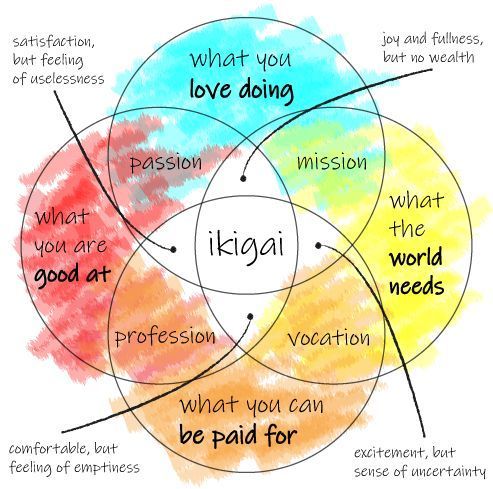Summary
Using the Japanese concept of Ikigai—which means "reason for being"—is a beautiful way to discover a project that truly resonates with you on a deep, personal level.
I have created a program that walks you through the process described below and currently testing the beta IKIGAI Legacy Project Creator for free. Ikigai means “reason for being”. It is possible to use this process for finding your purpose – your reason for being.
Try out the process here: Your passion project
The following article is taken directly from my research using ChatGPT with questions about the concept of Ikigai. I was curious as to what practical steps could be implemented to put this concept into practice. In that search I discovered this image is frequently used to illustrate the concept. (I did not locate the original image. Please share it with me if you know who did the design so I might give them credit.)
Google has many sources for this image.
Using the Japanese concept of Ikigai—which means “reason for being”—is a beautiful way to discover a project that truly resonates with you on a deep, personal level. Ikigai is often represented as the intersection of four key elements: what you love, what you’re good at, what the world needs, and what you can be paid for.
Here’s the step-by-step guide to help you plan and discover a legacy project that aligns with your passion, your reason for being, your Ikigai:
Go here to access the step by step “fill in the blank” process.
Step 1: Self-Reflection
- What You Love (Passion)
- Reflection Exercise: Spend some quiet time reflecting on what brings you joy and fulfillment. Consider hobbies, activities, or topics you could lose yourself in for hours. Ask yourself:
- What activities make me feel truly alive?
- What did I love doing as a child that I might have forgotten?
- What are the things I do that give me energy rather than drain it?
- Action Step: Write down a list of at least 10 things you love doing or are passionate about. Don’t filter yourself; let your thoughts flow freely.
- Reflection Exercise: Spend some quiet time reflecting on what brings you joy and fulfillment. Consider hobbies, activities, or topics you could lose yourself in for hours. Ask yourself:
- What You’re Good At (Profession)
- Reflection Exercise: Think about your skills, talents, and strengths. These can be both professional skills and personal talents. Ask yourself:
- What do people often come to me for help with?
- What tasks or skills have I mastered over the years?
- What do I do better than most people?
- Action Step: List out your top skills and talents. Include both tangible skills (like writing, teaching, or organizing) and intangible skills (like empathy, problem-solving, or communication).
- Reflection Exercise: Think about your skills, talents, and strengths. These can be both professional skills and personal talents. Ask yourself:
- What the World Needs (Mission)
- Reflection Exercise: Consider the issues, causes, or needs in the world that resonate with you. Think about where you feel a strong desire to make a difference. Ask yourself:
- What injustices or challenges in the world upset me the most?
- What causes do I feel drawn to support?
- How can I contribute to making the world a better place?
- Action Step: Identify 3-5 areas where you believe you can make a meaningful impact. These could be local community needs, environmental issues, social justice causes, or global challenges.
- Reflection Exercise: Consider the issues, causes, or needs in the world that resonate with you. Think about where you feel a strong desire to make a difference. Ask yourself:
- What You Can Be Paid For (Vocation)
- Reflection Exercise: Consider what people would be willing to pay for that aligns with your skills, passions, and the needs you’ve identified. Ask yourself:
- What services or products can I offer that people value?
- How have I earned money in the past that also brought me joy?
- Are there opportunities to monetize my skills or passions in a new way?
- Action Step: List potential ways you could monetize your skills and passions. This could include offering consulting services, creating products, teaching, or developing a new business idea.
- Reflection Exercise: Consider what people would be willing to pay for that aligns with your skills, passions, and the needs you’ve identified. Ask yourself:
Step 2: Find Your Ikigai Intersection
- Identify Overlaps
- Look for the intersections between your lists. Where do your passions, skills, the world’s needs, and potential income sources overlap? These intersections are where your Ikigai lies.
- For example, if you love teaching, are skilled at communication, see a need for environmental education, and can create educational content, your Ikigai might be developing an online course on sustainable living.
- Narrow Down Ideas
- Review the overlaps and narrow them down to 2-3 potential projects that excite you the most. Consider both your head (practicality, feasibility) and your heart (joy, fulfillment) when making your choices.
Step 3: Experiment and Explore
- Prototype Your Ideas
- Start small by creating a prototype or pilot of your project. For instance, if your idea is to create a community garden, begin by organizing a small gardening workshop or planting a garden in a local park.
- Gather feedback from participants, observe your own reactions, and see how the project feels in practice.
- Seek Feedback
- Share your ideas and prototypes with trusted friends, mentors, or community members. Listen to their feedback, suggestions, and insights.
- Be open to adjusting your project based on what you learn.
- Evaluate Emotional and Practical Fit
- Reflect on how you feel while working on your prototype. Does it bring you joy? Does it feel meaningful? Is it something you can see yourself doing long-term?
- Consider the practical aspects as well. Is it sustainable? Can it be scaled? Will it meet the needs you identified?
Step 4: Plan Your Project
- Create a Vision Statement
- Write a clear vision statement for your project that captures its purpose, the impact you want to make, and how it aligns with your Ikigai.
- Example: “To empower young people to become environmental stewards through hands-on gardening and sustainability education, creating a healthier planet for future generations.”
- Set Specific Goals
- Break down your project into specific, actionable goals. These could include milestones like securing funding, recruiting volunteers, or launching the project publicly.
- Use SMART goals (Specific, Measurable, Achievable, Relevant, Time-bound) to ensure you’re making tangible progress.
- Develop a Timeline
- Create a timeline for your project, including key deadlines and milestones. This will help you stay on track and ensure that your project progresses smoothly.
- Consider creating both short-term (3-6 months) and long-term (1-2 years) timelines to guide your efforts.
Step 5: Take Action and Adjust as Needed
- Start Small and Build
- Begin by taking small, consistent steps toward your goals. This could involve conducting initial research, reaching out to potential partners, or starting a blog to share your journey.
- Celebrate small wins along the way to stay motivated.
- Adapt and Evolve
- Be flexible and open to changes as you move forward. Your project might evolve in unexpected ways, and that’s okay. Trust your intuition and stay aligned with your Ikigai.
- Regularly revisit your reflection exercises to ensure you’re still aligned with what makes your heart sing.
- Share Your Journey
- Share your progress with others, whether through social media, a blog, or community events. This not only keeps you accountable but also inspires others who might resonate with your mission.
Step 6: Reflect and Celebrate
- Reflect on Your Journey
- Take time to reflect on how far you’ve come, what you’ve learned, and how your project has impacted both you and others. Reflect on whether your project continues to align with your Ikigai.
- If needed, make adjustments to ensure your project remains fulfilling and sustainable.
- Celebrate Your Success
- Celebrate the successes and milestones you’ve achieved, no matter how small. Recognize the difference you’re making and the joy you’ve found in pursuing your Ikigai.
- Consider ways to share your success with the broader community, perhaps by hosting a celebration event, writing a reflective blog post, or creating a “year in review” of your project’s impact.
By following these steps, you can create a legacy project that is deeply personal, meaningful, and uniquely yours, aligned with your Ikigai and capable of making your heart sing.
This website offers a “fill in the blank” form to help you discover your Ikigai and reason for being – your purpose.

